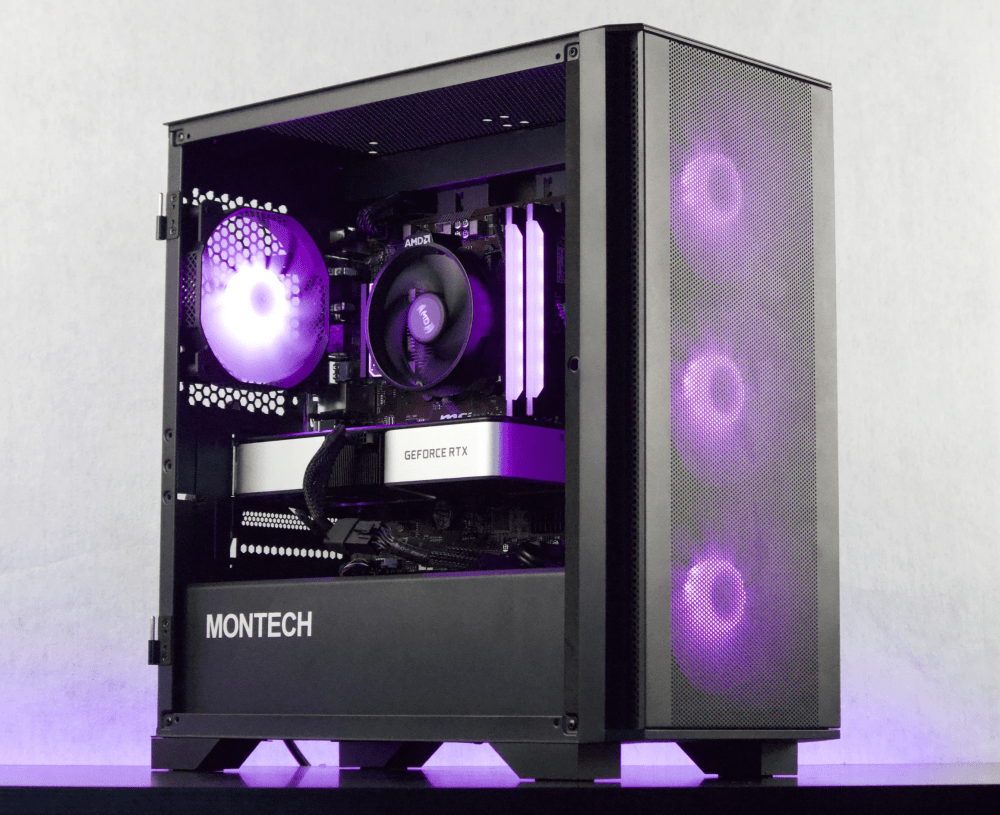Welcome to our blog post on how to reapply thermal paste to a GPU. If you're an avid gamer or a computer enthusiast, you probably understand the importance of keeping your GPU cool. Over time, the thermal paste on your GPU can dry out or become less effective, leading to increased temperatures and potential performance issues. In this guide, we will walk you through the process of reapplying thermal paste to your GPU, ensuring optimal cooling and performance.
In the first section, we will discuss the importance of thermal paste and why reapplying it is essential. Understanding how thermal paste works and its role in heat transfer is crucial in maintaining your GPU's health.
Next, we will guide you through the preparation stage. We will explain why reapplying thermal paste is necessary and the materials you will need for the reapplication process. Additionally, we will cover important safety precautions to ensure a smooth and risk-free experience.
Moving on, we will delve into the steps required to remove the old thermal paste. We will discuss the signs that indicate it's time to reapply thermal paste, as well as the tools you will need for its removal. We will provide a step-by-step guide on how to safely remove the old thermal paste without causing any damage to your GPU.
Once the old thermal paste has been removed, we will shift our focus to applying the new thermal paste. We will guide you on how to choose the right thermal paste for your GPU and the recommended application method. It's important to ensure proper spread and coverage to achieve optimal heat transfer.
After applying the new thermal paste, we will discuss reassembling the GPU and running initial tests. We will cover the process of reattaching the GPU to your computer and provide insights on running tests to evaluate the effectiveness of the thermal paste reapplication. Monitoring the GPU temperature during these tests will help ensure that everything is functioning as it should.
In conclusion, we will emphasize the importance of maintaining your GPU and knowing when to reapply thermal paste. Regularly checking your GPU's temperature and performing the reapplication process when necessary can help prolong its lifespan and maintain optimal performance.
Now that you understand the outline of this blog post, let's dive into the details of each section and learn how to reapply thermal paste to your GPU effectively.
Understanding the Importance of Thermal Paste
Thermal paste, also known as thermal compound or thermal grease, plays a crucial role in the cooling process of your GPU. It is a substance that fills the microscopic gaps between the GPU die and the heat sink, facilitating the transfer of heat from the GPU to the heat sink.
The primary purpose of thermal paste is to improve thermal conductivity between the two surfaces. The GPU generates a significant amount of heat during operation, and without proper heat dissipation, it can lead to overheating, reduced performance, and even hardware damage.
By applying thermal paste, you create a more efficient pathway for heat transfer, allowing the heat generated by the GPU to be effectively absorbed by the heat sink. This helps maintain lower temperatures and prevents the GPU from reaching critical levels that could result in thermal throttling or system instability.
Over time, the thermal paste can degrade or dry out, losing its effectiveness. This degradation can be accelerated by factors such as high temperatures, dust accumulation, or prolonged usage. When the thermal paste becomes less efficient, it hinders the heat transfer process, resulting in increased temperatures and potential performance issues.
Reapplying thermal paste to your GPU is essential to restore optimal heat dissipation. By removing the old, degraded thermal paste and applying a fresh layer, you ensure that the heat transfer between the GPU and the heat sink is efficient, allowing for better cooling performance and improved longevity of your GPU.
In the next section, we will guide you through the preparation stage, explaining why reapplying thermal paste is necessary and the materials you will need for the reapplication process. Additionally, we will cover important safety precautions to follow during the process.
Preparing to Reapply Thermal Paste
Before diving into the process of reapplying thermal paste to your GPU, it's important to properly prepare yourself and gather the necessary materials. In this section, we will discuss why reapplying thermal paste is necessary, the materials needed for the reapplication process, and the safety precautions you should follow to ensure a smooth and risk-free experience.
Why Reapplying Thermal Paste is Essential
Over time, the thermal paste on your GPU can deteriorate, dry out, or become less effective. This can lead to increased temperatures, which can negatively impact the performance and lifespan of your GPU. By reapplying thermal paste, you can restore optimal heat transfer and maintain lower temperatures, ensuring your GPU operates at its best.
Materials Needed for Reapplication
To successfully reapply thermal paste to your GPU, you will need the following materials:
-
Isopropyl Alcohol (preferably 90% or higher): This is used for cleaning the GPU die and the heat sink surface, removing any existing thermal paste residue.
-
Microfiber cloth or lint-free cloth: Used for wiping off the old thermal paste and cleaning the GPU die and heat sink.
-
Thermal paste: There are various types of thermal paste available, such as silicone-based, metal-based, or graphite-based. Choose a high-quality thermal paste that is compatible with your GPU.
-
Thermal paste applicator or spatula: This tool helps in evenly spreading the thermal paste on the GPU die, ensuring proper coverage.
-
Plastic gloves: Wearing gloves can prevent oils from your hands from contaminating the thermal paste or other components of the GPU.
-
Cotton swabs or Q-tips: These are useful for applying and spreading the isopropyl alcohol during the cleaning process.
Safety Precautions
When working with your GPU and applying thermal paste, it's important to follow these safety precautions:
-
Power off and unplug your computer: Before starting the reapplication process, make sure your computer is turned off and disconnected from the power source. This will prevent any accidental damage to your components and ensure your safety.
-
Work in a well-ventilated area: Adequate ventilation will help dissipate any fumes from the isopropyl alcohol or thermal paste.
-
Ground yourself: To prevent any static electricity discharge that could damage your GPU, ground yourself by touching a grounded metal object before handling any components.
-
Handle the GPU with care: GPUs are delicate components, so handle them gently to avoid any physical damage.
In the next section, we will discuss the signs that indicate your GPU needs thermal paste reapplication and the tools required for removing the old thermal paste.
Removing the Old Thermal Paste
In this section, we will cover the process of removing the old thermal paste from your GPU. It is important to remove the old paste properly to ensure a clean surface for the reapplication of the new thermal paste. We will discuss the signs that indicate your GPU needs thermal paste reapplication, the tools required for the removal process, and provide step-by-step instructions for safely removing the old thermal paste.
Signs Your GPU Needs Thermal Paste Reapplication
There are a few indicators that could suggest it's time to remove and replace the old thermal paste on your GPU:
-
Increased GPU temperatures: If you notice that your GPU is running hotter than usual, reaching higher temperatures during normal operation, it could be a sign that the thermal paste is no longer effectively transferring heat.
-
Performance issues: Overheating caused by degraded thermal paste can lead to performance degradation, such as reduced frame rates, stuttering, or system instability during intense GPU usage.
-
Dust accumulation: Dust can accumulate over time, affecting the efficiency of the thermal paste and hindering heat dissipation. If you notice excessive dust buildup on your GPU or heat sink, it may be a good time to consider reapplying thermal paste.
Tools Required for Removal
To remove the old thermal paste from your GPU, you will need the following tools:
-
Isopropyl Alcohol (preferably 90% or higher): This will help in cleaning the GPU die and heat sink surface, removing any residual thermal paste.
-
Microfiber cloth or lint-free cloth: Use this cloth to wipe off the old thermal paste and clean the GPU die and heat sink.
-
Cotton swabs or Q-tips: These are useful for applying and spreading the isopropyl alcohol during the cleaning process.
Steps to Safely Remove Old Thermal Paste
Follow these steps to safely remove the old thermal paste from your GPU:
-
Power off your computer and disconnect it from the power source.
-
Remove the GPU from your computer. Refer to your GPU's user manual or online resources for specific instructions on how to properly remove it.
-
Place the GPU on an anti-static mat or a non-conductive surface to protect it from any static electricity discharge.
-
Dip a cotton swab or Q-tip into the isopropyl alcohol and gently rub it on the GPU die and the heat sink surface to remove the old thermal paste. Be cautious not to apply excessive pressure or spill any liquid on the components.
-
Use a microfiber cloth or lint-free cloth to wipe off the dissolved thermal paste residue. Repeat this process until both the GPU die and the heat sink surface are clean and free from any residue.
-
Allow the GPU to dry completely before proceeding to the next steps. This will ensure that there is no moisture left that could interfere with the application of the new thermal paste.
In the next section, we will discuss how to choose the right thermal paste for your GPU and the recommended application method for the new thermal paste.
Applying the New Thermal Paste
In this section, we will guide you through the process of applying the new thermal paste to your GPU. Applying thermal paste correctly is crucial to ensure optimal heat transfer and cooling performance. We will discuss how to choose the right thermal paste for your GPU, the recommended application method, and how to ensure proper spread and coverage.
Choosing the Right Thermal Paste
When selecting thermal paste for your GPU, it's important to consider factors such as thermal conductivity, durability, and compatibility with your specific GPU model. There are different types of thermal paste available, including silicone-based, metal-based, and graphite-based.
Silicone-based thermal paste is the most common type and offers good thermal conductivity while being easy to apply. Metal-based thermal paste, such as those containing silver or copper particles, provides higher thermal conductivity but may be more difficult to apply. Graphite-based thermal paste is a good option for high-temperature applications, but it may be less effective for GPUs.
Ensure that the thermal paste you choose is compatible with your GPU. Check the manufacturer's guidelines or consult online resources for recommendations specific to your GPU model.
Application Method
Follow these steps to correctly apply thermal paste to your GPU:
-
Start by placing a small pea-sized or rice-sized dot of thermal paste at the center of the GPU die. The size of the dot may vary depending on the manufacturer's recommendations, but it's generally recommended to start with a small amount and adjust as needed.
-
Using a thermal paste applicator or a spatula, gently spread the thermal paste evenly across the GPU die. You can also use a plastic card or your gloved finger (if recommended by the thermal paste manufacturer) to achieve an even spread.
-
Avoid using excessive force or pressure while spreading the thermal paste to prevent any damage to the GPU die or surrounding components.
-
Make sure that the thermal paste covers the entire GPU die, ensuring that there are no gaps or uneven application.
Ensuring Proper Spread and Coverage
To ensure proper spread and coverage of the thermal paste, consider the following tips:
-
Avoid applying too much thermal paste as it can lead to excess squeezing out and potentially causing short circuits or interfering with other components.
-
The thermal paste should form a thin, even layer on the GPU die, with no visible gaps or air bubbles.
-
Double-check that the thermal paste is applied only to the GPU die and not on any surrounding components.
-
Once the thermal paste is applied, carefully place the heat sink back onto the GPU, ensuring proper alignment.
In the next section, we will discuss reassembling your GPU and running initial tests to evaluate the effectiveness of the thermal paste reapplication.
Reassembling and Testing the GPU
Once you have successfully applied the new thermal paste to your GPU, it's time to reassemble the GPU and perform some initial tests to ensure everything is functioning properly. In this section, we will guide you through the process of reattaching the GPU, running initial tests, and monitoring the GPU temperature.
Reattaching the GPU
Follow these steps to reattach the GPU to your computer:
-
Carefully align the GPU with the PCIe slot on your motherboard.
-
Gently slide the GPU back into the slot, ensuring it is properly seated.
-
Secure the GPU in place by tightening the screws or latches on the PCIe slot bracket.
-
Reconnect the power cables to the GPU, ensuring they are securely plugged in.
Running Initial Tests
After reassembling the GPU, it's important to run some initial tests to check for any potential issues and ensure proper functionality. Here's what you can do:
-
Power on your computer and boot into your operating system.
-
Launch a GPU monitoring software, such as MSI Afterburner or GPU-Z, to monitor the GPU temperature and performance.
-
Run a stress test or benchmarking tool to put your GPU under load and assess its stability. This will help you identify any potential issues, such as overheating or artifacts.
-
Monitor the GPU temperature during the stress test and ensure that it stays within safe limits. Refer to your GPU manufacturer's guidelines or online resources for the recommended temperature ranges for your specific GPU model.
Monitoring GPU Temperature
Monitoring the GPU temperature is essential to ensure that the thermal paste reapplication has been successful and that your GPU is running within safe operating temperatures. Here are some tips for monitoring GPU temperature:
-
Use GPU monitoring software: Install and run software that provides real-time monitoring of your GPU temperature. These tools display the temperature in Celsius or Fahrenheit and allow you to track any temperature spikes or abnormalities.
-
Check manufacturer guidelines: Refer to your GPU manufacturer's guidelines or specifications to determine the recommended temperature range for your specific GPU model. This will help you assess whether your GPU is operating within safe limits.
-
Regularly monitor temperature during usage: Keep an eye on the GPU temperature during typical usage scenarios, such as gaming or rendering, to ensure that it remains within acceptable ranges.
-
Consider additional cooling measures: If you find that your GPU temperatures are still higher than desired, you may need to explore additional cooling solutions, such as improving case airflow, installing additional fans, or even considering aftermarket GPU cooling options.
In the next section, we will conclude our guide by discussing the importance of maintaining your GPU and knowing when to reapply thermal paste.
Conclusion
In conclusion, reapplying thermal paste to your GPU is an important maintenance task that can greatly impact its cooling performance and overall lifespan. By understanding the importance of thermal paste and following the correct procedures, you can ensure optimal heat transfer and prevent potential issues caused by overheating.
Throughout this guide, we have covered the necessary steps for reapplying thermal paste to your GPU. We started by emphasizing the significance of thermal paste and why it is essential to maintain its effectiveness. We then discussed the preparation stage, including the materials needed and safety precautions to follow.
Moving forward, we provided instructions for removing the old thermal paste, highlighting the signs that indicate when reapplication is necessary and the tools required for the process. Following that, we explained how to choose the right thermal paste for your GPU and the recommended application method to achieve proper spread and coverage.
Finally, we discussed the reassembly process of the GPU and running initial tests to ensure everything is functioning as it should. We emphasized the importance of monitoring the GPU temperature during these tests to ensure it stays within safe operating limits.
Remember, maintaining your GPU goes beyond just reapplying thermal paste. Regularly monitoring the temperature, keeping your GPU clean of dust, and ensuring proper airflow in your system are all important aspects of GPU maintenance.
Knowing when to reapply thermal paste depends on various factors, including usage patterns, ambient temperatures, and the specific thermal paste used. As a general guideline, it is recommended to check your GPU's thermal paste every one to two years or if you notice increased temperatures or performance issues.
By following the steps outlined in this guide and staying proactive in maintaining your GPU, you can enjoy better cooling performance, improved longevity, and optimal gaming or computing experiences.
We hope this comprehensive guide has provided you with the knowledge and confidence to successfully reapply thermal paste to your GPU. Happy gaming and computing!
Ready to level up your game? Check out Jawa for the best deals on PC gaming hardware





